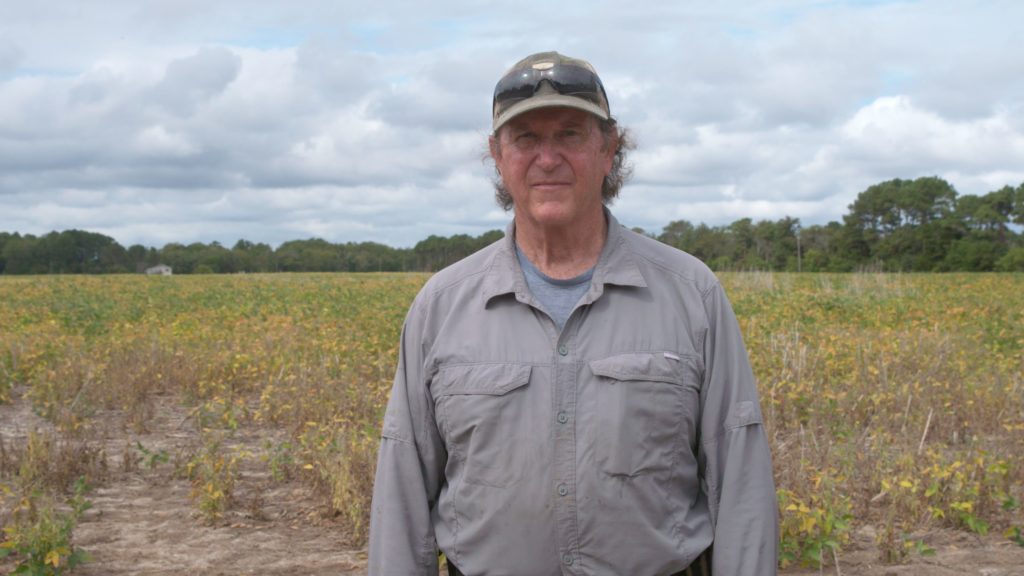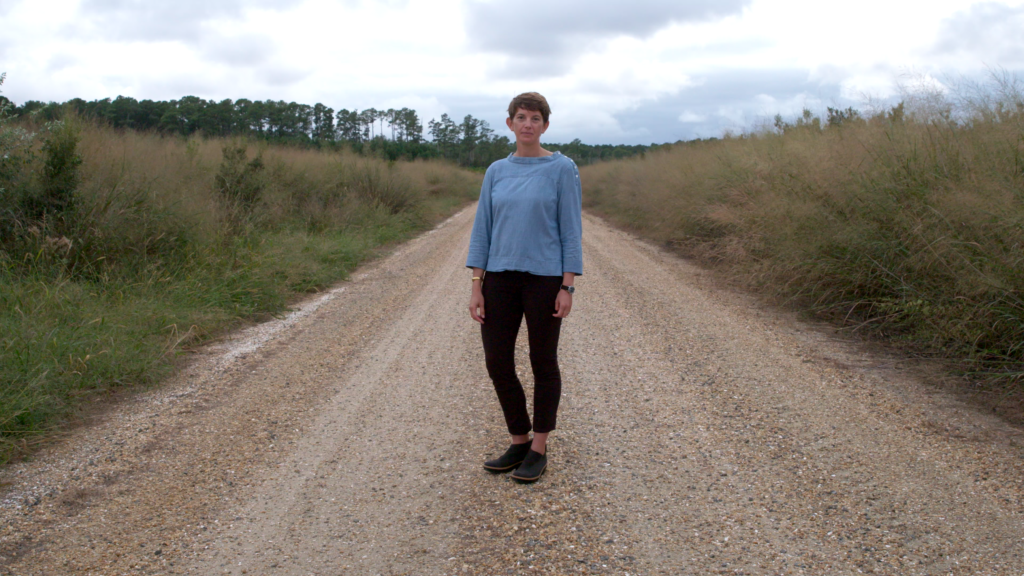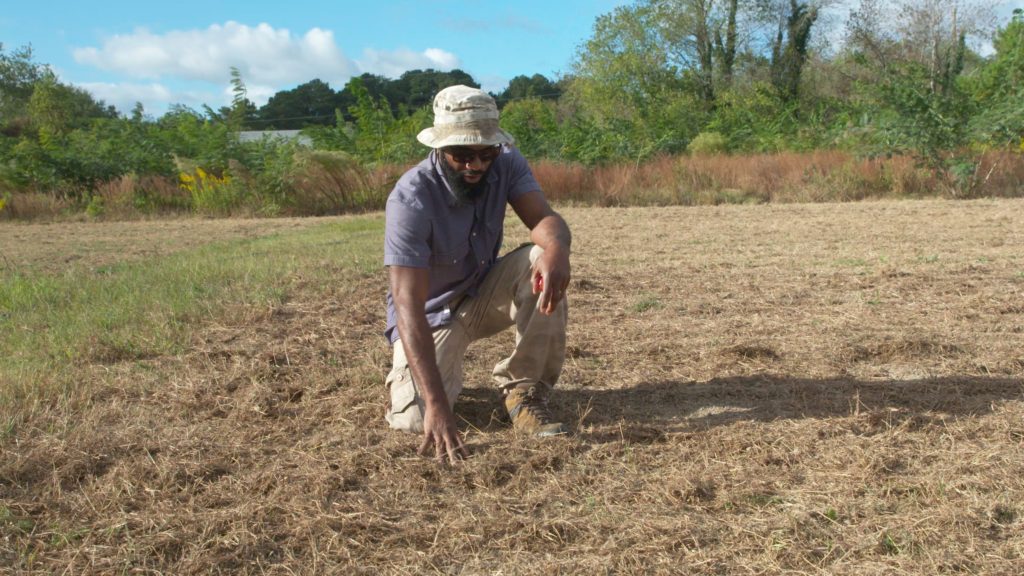Photo by Neil Grochmal. The Eastern Shore’s historically nutrient-rich farmland is gradually succumbing to sea level rise.
This story is part of “At A Crossroads,” a WHRO Public Media series exploring how coastal Virginia is dealing with higher waters due to climate change. The project is funded by the Pulitzer Center on Crisis Reporting as part of its nationwide Connected Coastlines reporting initiative.
By Sam Turken
Agriculture has been a central part of life and business on Virginia’s Eastern Shore since its settlement 400 years ago.
The climate isn’t too hot or cold, and the soil is fertile. For Lynn Gayle, it’s been a perfect place to grow his crops the past three decades.
“Farming is a lifestyle,” he said. “My son farms with me, and we tend about 2,500 acres.”
Gayle harvests commodities including corn, soybean and rapeseed, a yellow flowering crop that produces oil for engines and plastics.
But now the Eastern Shore’s historically nutrient-rich farmland is gradually succumbing to the rising seas.
Gayle farms a lush 75-acre field bordering the ocean and full of soybeans — except for a small bare patch close to the water where his soybeans died.
“[During] occasional high tides, this would be underwater right here,” he said during a tour of the field. “And you can see the salt patches — the white residue — on the soil.”
It’s even worse at another field Gayle used to plant. Twenty acres completely failed, he said.

Coastal Virginia farmers are watching their land flood and crops die more often as the region experiences the fastest average rate of sea level rise on the Atlantic coast. It’s making them question whether agriculture will be a sustainable source of income in the future.
Take Gayle’s son, Sands, who’s inheriting the business after growing up playing with green John Deere tractor toys. He said hundreds of thousands of dollars are at stake.
“A third of the acreage that I farm could be right on the water and directly affected by sea level rise,” Sands, 32, said. “I’m going to have to figure something out.”
Water levels around coastal Virginia have risen about 20 inches over the last 100 years. Projections from the National Oceanic and Atmospheric show seas going up nearly 7 feet by 2100.

An invisible killer
The rising waters aren’t impacting all farmland equally. On the Eastern Shore, for example, scientists say higher-elevated fields facing the Chesapeake Bay in Northampton County and those near the ocean in Accomack County are at a less immediate risk.
But land in Nassawadox illustrates what lower-lying fields could become in the next few decades.
During a tour of the Nature Conservancy’s Brownsville Preserve, Cora Baird points out areas that were farmed from the 1650s until the early 2000s. That’s when farmers had enough of saltwater dehydrating their soybean and corn crops to death and stopped planting the fields.
As saltwater has continued to invade the land, it’s become a thick salt marsh.
“So like the dark green shrub that’s poking out in the grass, that’s a salt-associated shrub. The wax myrtle,” said Baird, who studies sea level rise around the Eastern Shore for the University of Virginia’s Coastal Research Center.
Baird noted the threat extends across the Chesapeake Bay to Virginia’s mainland.
“The Guinea Neck areas of Gloucester [County] are experiencing this as much or more so than some of our regions on the Eastern Shore,” she said.

The seawater isn’t just coming in from the ocean, rivers and creeks. As part of a process known as saltwater intrusion, scientists say it’s rising from under the land, mixing with groundwater and making the soil wetter and saltier — an invisible killer that extends south to Florida.
Thelonius Cook says this is directly impacting his inland farm, which sits off the Eastern Shore’s main highway.
After studying information technology in college, Cook switched his focus to creating and running a sustainable produce farm. He grows vegetables, herbs and fruit without tilling his soil or using fertilizer and pesticides. He sells his produce at farmers’ markets around the state.
But during rainstorms, water flows off the road onto Cook’s land and doesn’t drain well because the ground is already wet from saltwater intrusion. The flooding has inundated one of Cook’s greenhouses multiple times, killing $30,000 worth of vegetable crops the past few years.
“Because we have this high water table, it just has nowhere to go,” Cook, 42, said. “It makes you feel deflated because there’s so much investment in this farm. You want to make sure this is here for the next generation.”

Further complicating the problem around the Eastern Shore is the fact that it’s a narrow peninsula, so there’s a limited amount of land available for agriculture.
Lynn Gayle, who leases his fields, said the process of securing rights to land for farming is already competitive. Farmers are always searching for more acreage and can try to outbid each other for the best fields. That process may only intensify as the rising waters inundate more fields.
“If seaside land becomes less desirable and you have to move off of it, then you’re going to try to make up that acreage in other locations,” Gayle said. “And that’s going to affect multiple farmers.”
There could be some ways farmers hold on to flood vulnerable fields for some time.
Scientists are testing salt tolerant crops like barley and quinoa. Farmers also can try to keep the water away by digging ditches and berms around their fields.

During a tour of his farm, Cook said he’s trying to plant a buffer of trees and bushes around his fields. Hopefully, it will help soak up floodwater flowing off the highway, he said.
The question, though, is for how long.
As sea levels continue to rise, he said, “it’s possible that in my lifetime [I won’t be] able to farm out here on the Eastern Shore.”

